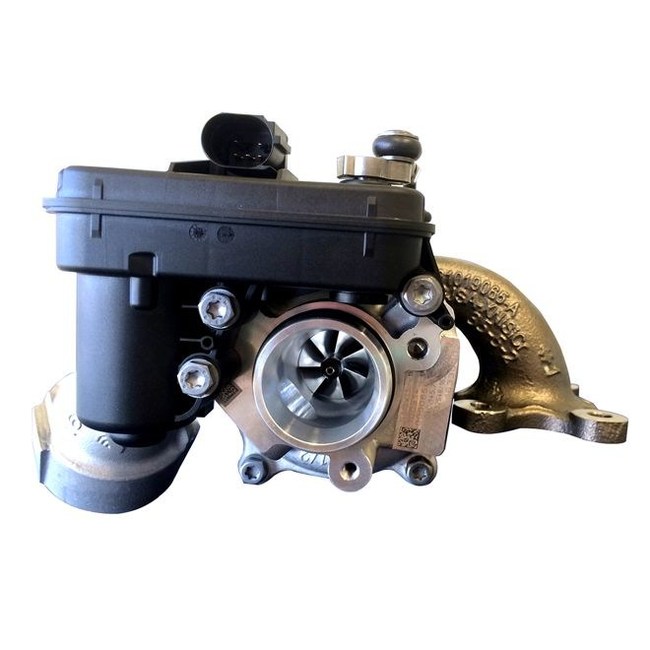SÃO PAULO, Sept. 23, 2020 /PRNewswire/ — BorgWarner has expanded the supply of its compact B01 turbocharger by equipping the newly launched Volkswagen Nivus crossover. With an EA211 1.0-liter 200 TSI engine, the vehicle features first-of-its-kind turbo technology for the Brazilian market, offering a desired combination of better performance, improved energy efficiency and reduced fuel consumption.

“The use of boosting technology helps customers meet emissions requirements thanks to the boost in efficiency that our technology delivers. With a market demand for reduction in fuel consumption, we are happy to supply a solution that allows for savings to the end customer, along with enhanced engine performance,” says Joe Fadool, President and General Manager, BorgWarner Emissions, Thermal and Turbo Systems.
The B01 turbocharger helps reduce vehicle emissions through the use of advanced materials and technologies that meet the engine’s needs. Likewise, it is capable of withstanding exhaust temperatures of up to 1,050 degrees Celsius. Its construction and operation also have a milled compressor rotor, with an optimized bearing system and a relief valve controlled by an electric actuator, resulting in less noise during operation. Another advantage is its compact design, which takes into account the construction of engines with low displacement, without compromising performance. Overall, the Nivus’ engine boasts 126 horsepower (128 PS) and 147 lb-ft (200Nm) of torque, delivering a fast acceleration response and a unique and pleasurable driving experience.
About BorgWarner
BorgWarner Inc. (NYSE: BWA) is a global product leader in clean and efficient technology solutions for combustion, hybrid and electric vehicles. With manufacturing and technical facilities in 67 locations in 19 countries, the company employs approximately 29,000 worldwide. For more information, please visit borgwarner.com.
Statements in this news release (this “Release”) may contain forward-looking statements as contemplated by the 1995 Private Securities Litigation Reform Act that are based on management’s current outlook, expectations, estimates and projections. Words such as “anticipates,” “believes,” “continues,” “could,” “designed,” “effect,” “estimates,” “evaluates,” “expects,” “forecasts,” “goal,” “guidance,” “initiative,” “intends,” “may,” “outlook,” “plans,” “potential,” “predicts,” “project,” “pursue,” “seek,” “should,” “target,” “when,” “will,” “would,” and variations of such words and similar expressions are intended to identify such forward-looking statements. Further, all statements, other than statements of historical fact contained or incorporated by reference in this Release that we expect or anticipate will or may occur in the future regarding our financial position, business strategy and measures to implement that strategy, including changes to operations, competitive strengths, goals, expansion and growth of our business and operations, plans, references to future success and other such matters, are forward-looking statements. Accounting estimates, such as those described under the heading “Critical Accounting Policies” in Item 7 of our most recently-filed Annual Repot on Form 10-K (“Form 10-K”), are inherently forward-looking. All forward-looking statements are based on assumptions and analyses made by us in light of our experience and our perception of historical trends, current conditions and expected future developments, as well as other factors we believe are appropriate in the circumstances. Forward-looking statements are not guarantees of performance, and the Company’s actual results may differ materially from those expressed, projected or implied in or by the forward-looking statements.
You should not place undue reliance on these forward-looking statements, which speak only as of the date of this Release. Forward-looking statements are subject to risks and uncertainties, many of which are difficult to predict and generally beyond our control, that could cause actual results to differ materially from those expressed, projected or implied in or by the forward-looking statements. These risks and uncertainties, among others, include: our dependence on automotive and truck production, both of which are highly cyclical; our reliance on major OEM customers; commodities availability and pricing; supply disruptions; fluctuations in interest rates and foreign currency exchange rates; availability of credit; our dependence on key management; our dependence on information systems; the uncertainty of the global economic environment; the outcome of existing or any future legal proceedings, including litigation with respect to various claims; future changes in laws and regulations, including, by way of example, tariffs, in the countries in which we operate; and other risks noted in reports that we file with the Securities and Exchange Commission, including Item 1A, “Risk Factors” in our most recently-filed Form 10-K. We do not undertake any obligation to update or announce publicly any updates to or revisions to any of the forward-looking statements in this presentation to reflect any change in our expectations or any change in events, conditions, circumstances, or assumptions underlying the statements.
SOURCE BorgWarner
